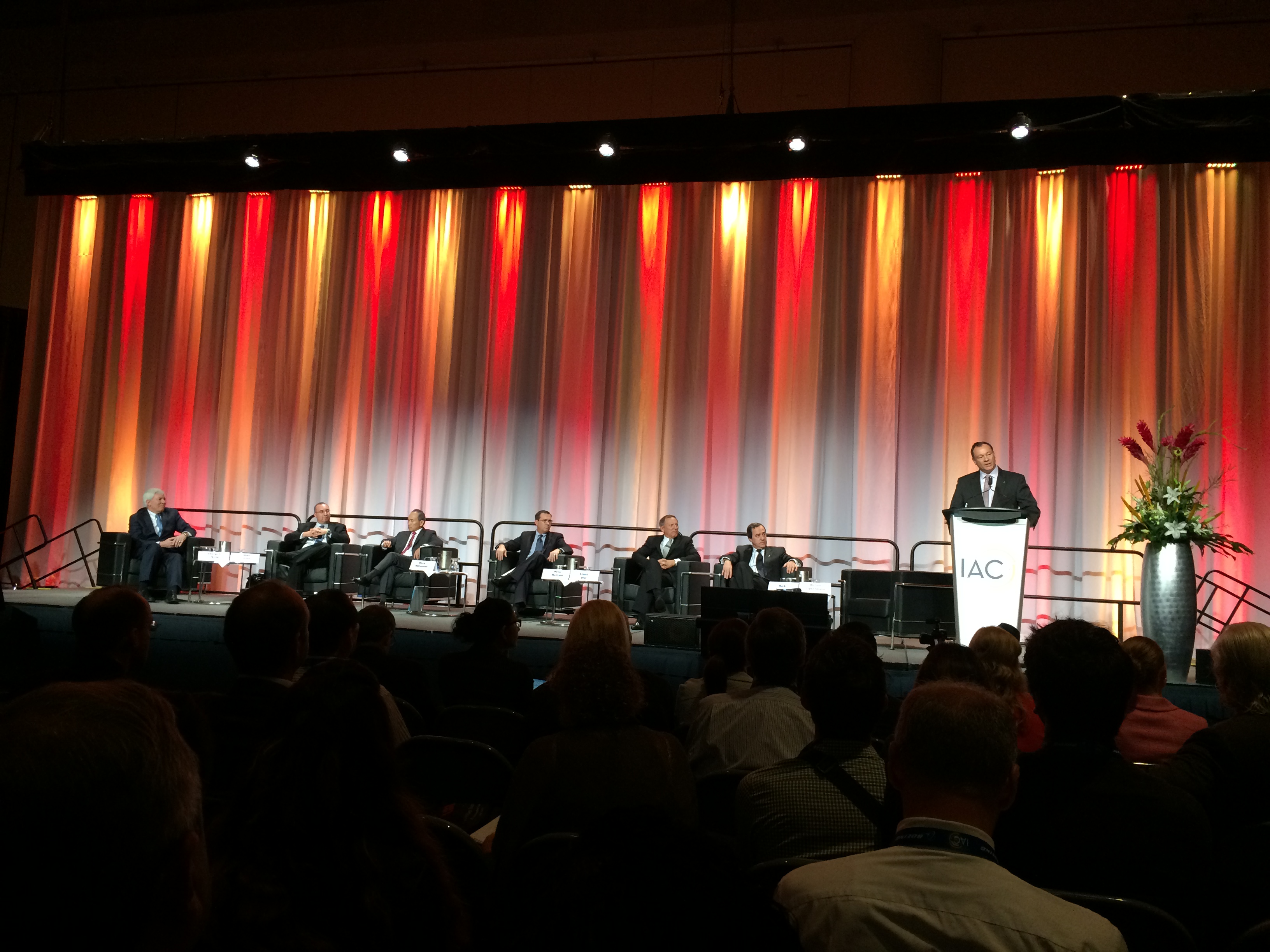IAC 2014 Plenary Session on Commercial Space Flight
Moderator Michael Lopez-Alegria is the President of the Commercial Spaceflight Federation. He says the Ansari X-Prize marks the start of commercial spaceflight.
Panel Introductions
Mark Sirangelo is the Corporate Vice Pesident of Sierra Nevada Corporation. He says the growth of commercial spaceflight is a “suprise” – to see so many architectures in different sectors, and some of the greatest minds bringing technology and looking at it in the different way. He says the first attempts at government-privatization programs like Commercial Crew were not met with budgetary support. Initially about $50M split up between a few companies. This year it was $525M split over 2 companies. Budget for next few years is $4 or 5 B USD. He thinks this is a demonstration of what these companies have been able to achieve and obviously thinks this is terrific.
As a note, Sierra Nevada Corp was not selected recently by NASA for the Commercial Crew Program and is staging a legal protest but obviously nobody mentioned this on the panel. As a result he was careful to mention that Dreamchaser has a Global Project initiative, and that SNC will be publicly discussing their strong relationship with Lockheed Martin which he feels is a partnership in the best combination of a traditional aerospace with an emerging company. SNC will also be making an announcement on their partnership with Paul Allen’s Vulcan and Stratolaunch platform.
Stuart Witt spoke next – he is the CEO and General Manager of Mojave Air and Spaceport. He comes to industry from the R&D perspective – he feels the world needs a place to take some risk, since there is an obsession of absolute safety in Western civilization. Somebody has to create a place and an entity for risk taking. He showed a video in which participants call Mojave spaceport an “absolute national treasure”, and say it is the right space with the (W?)right attitude. He gave a shoutout to Silicon Valley and Wright Brothers’ innovative ethic. During the video, the CEO of Virgin Galactic says he feels that Mojave is only place where you can build, test, fly in the world.
Next, the Boeing and SpaceX representatives spoke about the NASA Commercial Crew award. Boeing rep Peter McGrath, Director of Business Development, Space Exploration Division, says that Boeing brings a unique blend of history and legacy, plus commercial and space history and innovative capabilities. He said they are flying on Atlas 5 which has 49 successful launches to date. Right now Boeing is actively manufacturing all of their space hardware, and working on the abort system, and a launch tower to put crew on it. It is based on Apollo – rich heritage, and a very stable parachute and landing approach. He kept talking about maturity and heritage a lot – the message from Boeing is obviously “we are doing what is proven to work”. This isn’t a NewSpace company. He pointedly mentioned that Boeing is the only participant that completed ALL milestones during the CC CAP testing period and design review.
SpaceX rep Barry Matsumori is the SVP of Business Development and Sales. He describes SpaceX as highly vertically integrated – with a factory that has launch vehicles, engines, machine shops, avionics. The company believes in a highly integrated structure which allows a lot of agility, cost savings, and makes them very competitive in the marketplace. His message – the company is young, agile, scrappy. They have had a highly active year and a Dragon rocket is currently berthed at ISS.
Bigelow Aerospace rep is Mike Gold, Director of D.C. Operations and Business Growth. He says “we are the destination. We want to give the transportation providers somewhere to go and something to do”. Bigelow is developing expandable habitats. NASA came up with the concept of tent-like habitat that can expand out in orbit. This results in a lot more usable volume, better protection against physical debris, and enhanced protection against radiation. Bigelow bought the patents from NASA. They have had two successful demonstration launches in 2006 and 2007 via Russian nuclear missiles. Their next launch is in 2015 and this is a huge milestone as it will be attached to ISS.
Finally, FAA rep Dr George Neild , who is Associate Administrator for Commercial space Transport Administration spoke (he has a background from Orbital Sciences Corporation). He talked about historic (government) space achievements. He epects to see dramatic achievements in how we do business in space. Private industry is going to play a key role in space sector activities especially in regards to low earth orbit and suborbital activities.He posed the rhetorical question: What does private industry have going for it? 1) Cost savings. Capable of operating more efficiently. 2) Technological and organizational Innovation. 3) They may have greater risk tolerance. 4) The private sector is well positioned to identify and exploit new markets.
So if commercial space is so great, why don’t we operate that way all the time? To fully take advantage of commercial approaches would dramatically change how government does business. Government perhaps should invest, partner with industry, buy services from industry. NASA did that for transporting cargo and is attempting to do that for commercial crew. He feels the commercial space sector is tantalizingly close to doing space without government involvement. He says however that government will continue to be engaged for safety purposes if nothing else. And he says it should foster the continuing dialog between industry, government and academia.
Panel Questions
At the risk of sounding cynical, some of these questions might have been planted for the participants but they led to interesting conversations.
A question for the panel: What makes commercial space industry different? Sierra Nevada Corporate spokesperson: Passion – there is a belief in what they are doing, putting their lives and futures on the line. It’s not just about the business. SpaceX rep: Not being told what to do – being able to provide a service that reflects the market rather than making a specified product is a big deal. This allows management or risk taking. Bigelow rep: Fixed price versus cost plus model. Asking the private sector to put their own money on the table rather than the taxpayer. This leads to a giant cost savings. Not easy to facilitate this model in a bureaucracy. FAA rep: It is exciting that the number of launches historically has been about how much money the US Congress can appropriate in a year. However now and in the future it will be based purely on how much the market will bear.
Question to SNC head. What else can Dreamchaser do? He says it is a space utility vehicle. Therefore Commercial Crew is not the only mission profile for it. Dreamchaser can do servicing and repair, refueling, movement of satellites potentially. It can do all this from same basic platform which is a win for everyone. On the international side they believed in the beginning about creating a strong partnership network. They think a company should know what can you do well and what can you not do well, and bring on experts and partners to help in areas where you can’t do well. He feels they have created a strong partnership team containing many industrial partners, over 30 international universities, and multiple NASA centres. SNC is a global enterprise built around commercial space and transporation capabilities.
Question to head of Mojave about suborbital launch issues (foreign workers and ITAR restrictions). He feels the surborbital industry is a borderless industry, and that sometime in next decade suborbit point-to-point travel should be as mainstream as buying a ticket and flying to Los Angeles is today.
Related to the discussion about foreign internationals working on space tech – Mike Gold joked that ITAR along with gravity are the hardest things for industry to overcome.
A question to Boeing and SpaceX about being operational for the 2017 Commercial Crew date – Boeing and SpaceX both say they can make 2017 date (what else would they say 🙂 ).
Bigelow rep is asked if their technology can work on the moon. He says it was originally made for Mars. However he feels the Moon makes more sense as a destination than anything else beyond LEO. It’s actually pretty easy to imagine Bigelow expandable habitats being used to make scientific and tourist habitats on the moon.
A final note from the FAA rep Dr. Neild – he says there is a lot of work in policy, legal, regulatory framework in addition tto technology, all of which is required to develop commercial space capabilities. He referenced the development of space ports such as Mojave, and foreign agreemnts ex with the UK government which was recently inked at Farnborough.
Overall this was a very interesting session, in a crowded room. As always some of the things that were not said were as noteworthy as things that were said. Commercial Crew protest was definitely the elephant in the room.




